2020 TOYOTA HILUX light
[x] Cancel search: lightPage 673 of 744
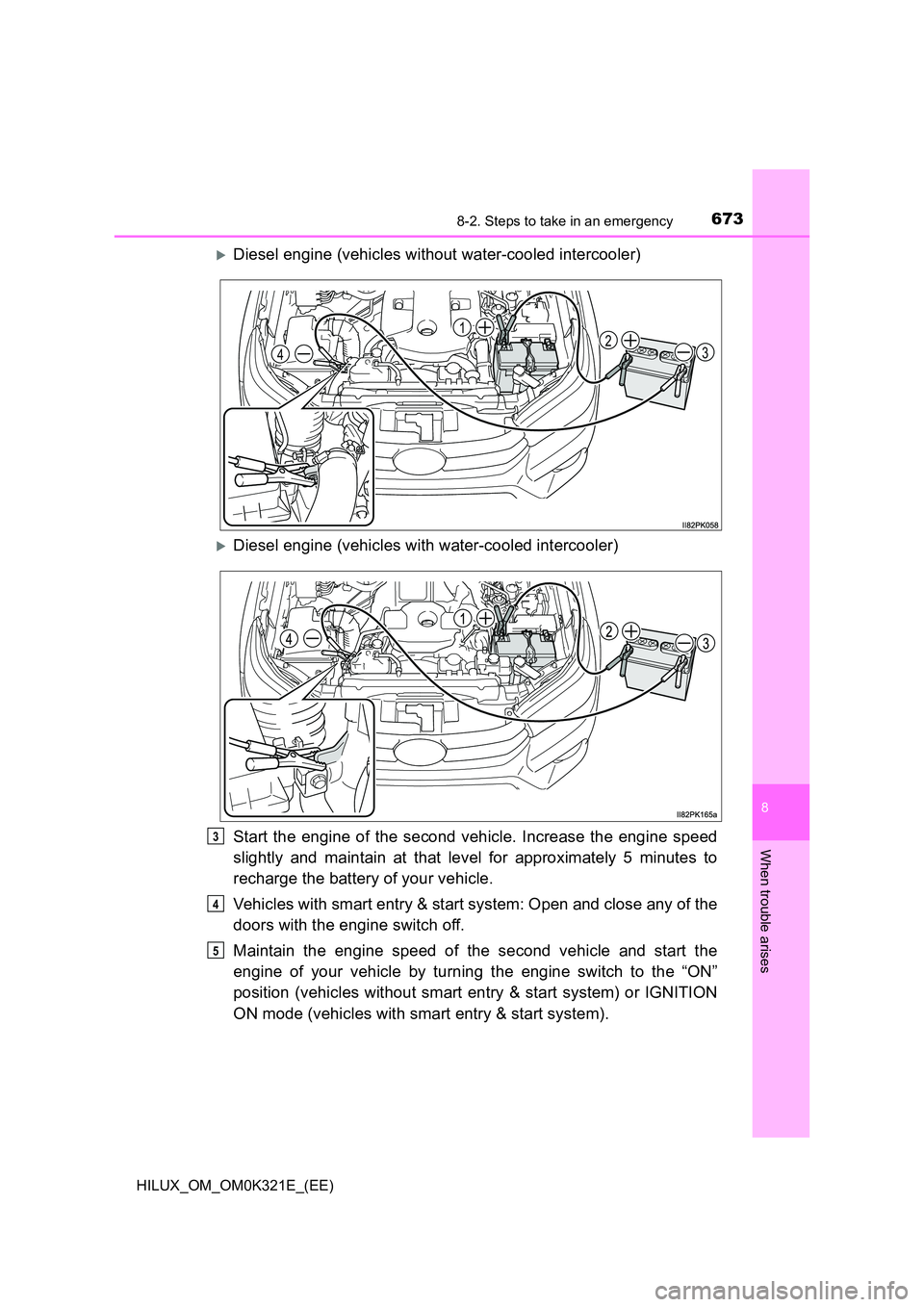
6738-2. Steps to take in an emergency
HILUX_OM_OM0K321E_(EE)
8
When trouble arises
Diesel engine (vehicles without water-cooled intercooler)
Diesel engine (vehicles with water-cooled intercooler)
Start the engine of the second vehicle. Increase the engine speed
slightly and maintain at that level for approximately 5 minutes to
recharge the battery of your vehicle.
Vehicles with smart entry & start system: Open and close any of the
doors with the engine switch off.
Maintain the engine speed of the second vehicle and start the
engine of your vehicle by turning the engine switch to the “ON”
position (vehicles without smart entry & start system) or IGNITION
ON mode (vehicles with smart entry & start system).
324
1
3
4
5
Page 674 of 744

6748-2. Steps to take in an emergency
HILUX_OM_OM0K321E_(EE)
Once the vehicle’s engine has started, remove the jumper cables in
the exact reverse order from which they were connected.
Once the engine starts, have the vehicle inspected at any authorized
Toyota retailer or Toyota authorized repairer, or any reliable repairer
as soon as possible.
■ Starting the engine when the battery is discharged (vehicles with auto-
matic transmission)
The engine cannot be started by push-starting.
■ To prevent battery discharge
● Turn off the headlights and the audio system while the engine is off.
(Vehicles with Stop & Start system: Except when the engine is stopped due
to the Stop & Start system)
● Turn off any unnecessary electrical components when the vehicle is running
at a low speed for an extended period, such as in heavy traffic.
■ When the battery is removed or discharged
● Information stored in the ECU is cleared. When the battery is depleted, have
the vehicle inspected at any authorized Toyota retailer or Toyota authorized
repairer, or any reliable repairer.
● The power windows may not close normally. In this case, initialize the power
windows. (if equipped) ( P. 250)
■ Charging the battery
The electricity stored in the battery will discharge gradually even when the
vehicle is not in use, due to natural discharge and the draining effects of cer-
tain electrical appliances. If the vehicle is left for a long time, the battery may
discharge, and the engine may be unable to start. (The battery recharges
automatically during driving.)
■ When recharging or replacing the battery (vehicles with smart entry &
start system)
● In some cases, it may not be possible to unlock the doors using the smart
entry & start system when the battery is discharged. Use the wireless
remote control or the mechanical key to lock or unlock the doors.
● The engine may not start on the first attempt after the battery has recharged
but will start normally after the second attempt. This is not a malfunction.
● The engine switch mode is memorized by the vehicle. When the battery is
reconnected, the system will return to the mode it was in before the battery
was discharged. Before disconnecting the battery, turn the engine switch off.
If you are unsure what mode the engine switch was in before the battery dis-
charged, be especially careful when reconnecting the battery.
● Vehicles with Stop & Start system: After the battery terminals have been dis-
connected and reconnected or, the battery has been replaced, the Stop &
Start system may not automatically stop the engine for approximately 5 to
60 minutes.
6
Page 676 of 744
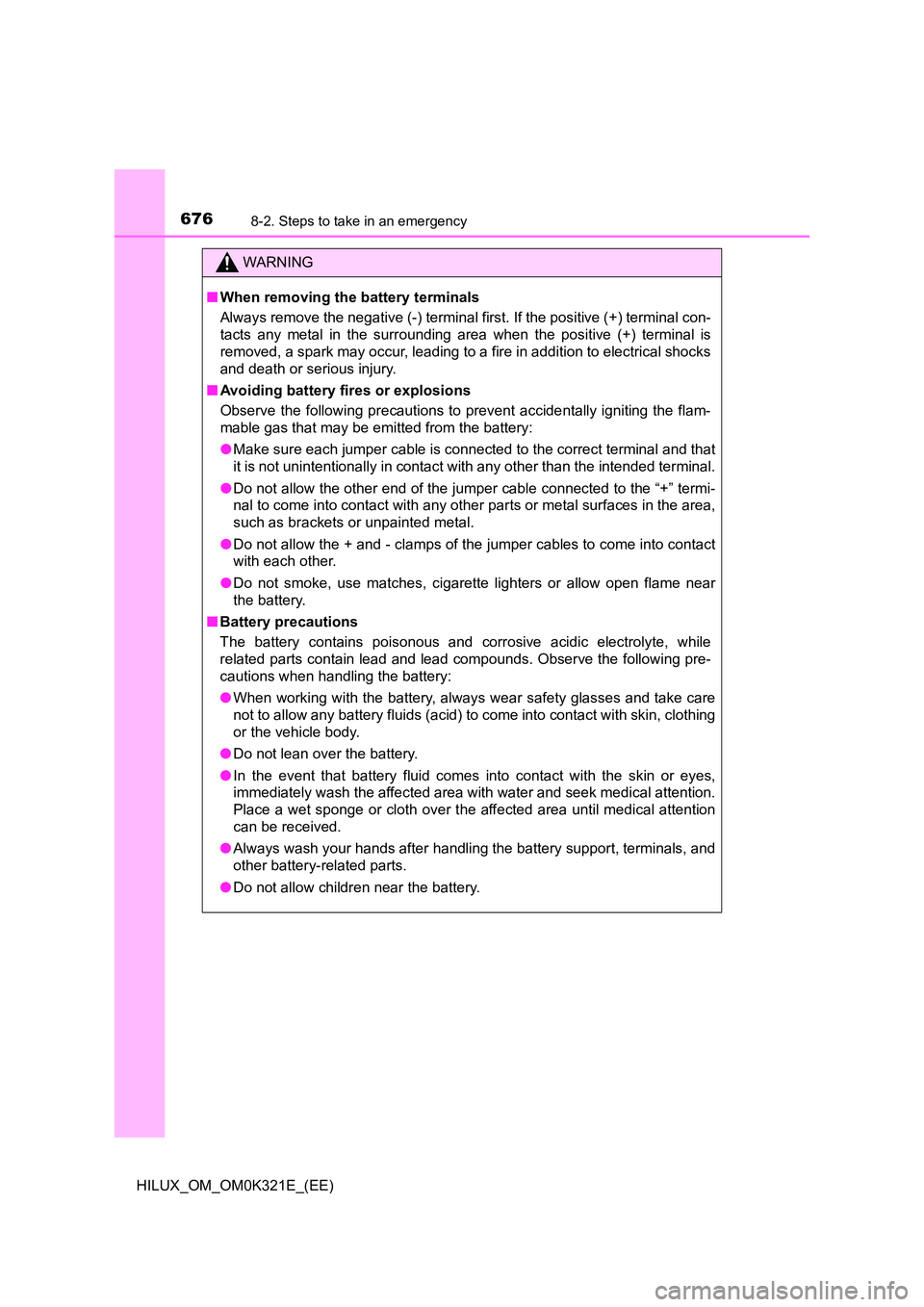
6768-2. Steps to take in an emergency
HILUX_OM_OM0K321E_(EE)
WARNING
■When removing the battery terminals
Always remove the negative (-) terminal first. If the positive (+) terminal con-
tacts any metal in the surrounding area when the positive (+) terminal is
removed, a spark may occur, leading to a fire in addition to electrical shocks
and death or serious injury.
■ Avoiding battery fires or explosions
Observe the following precautions to prevent accidentally igniting the flam-
mable gas that may be emitted from the battery:
● Make sure each jumper cable is connected to the correct terminal and that
it is not unintentionally in contact with any other than the intended terminal.
● Do not allow the other end of the jumper cable connected to the “+” termi-
nal to come into contact with any other parts or metal surfaces in the area,
such as brackets or unpainted metal.
● Do not allow the + and - clamps of the jumper cables to come into contact
with each other.
● Do not smoke, use matches, cigarette lighters or allow open flame near
the battery.
■ Battery precautions
The battery contains poisonous and corrosive acidic electrolyte, while
related parts contain lead and lead compounds. Observe the following pre-
cautions when handling the battery:
● When working with the battery, always wear safety glasses and take care
not to allow any battery fluids (acid) to come into contact with skin, clothing
or the vehicle body.
● Do not lean over the battery.
● In the event that battery fluid comes into contact with the skin or eyes,
immediately wash the affected area with water and seek medical attention.
Place a wet sponge or cloth over the affected area until medical attention
can be received.
● Always wash your hands after handling the battery support, terminals, and
other battery-related parts.
● Do not allow children near the battery.
Page 682 of 744
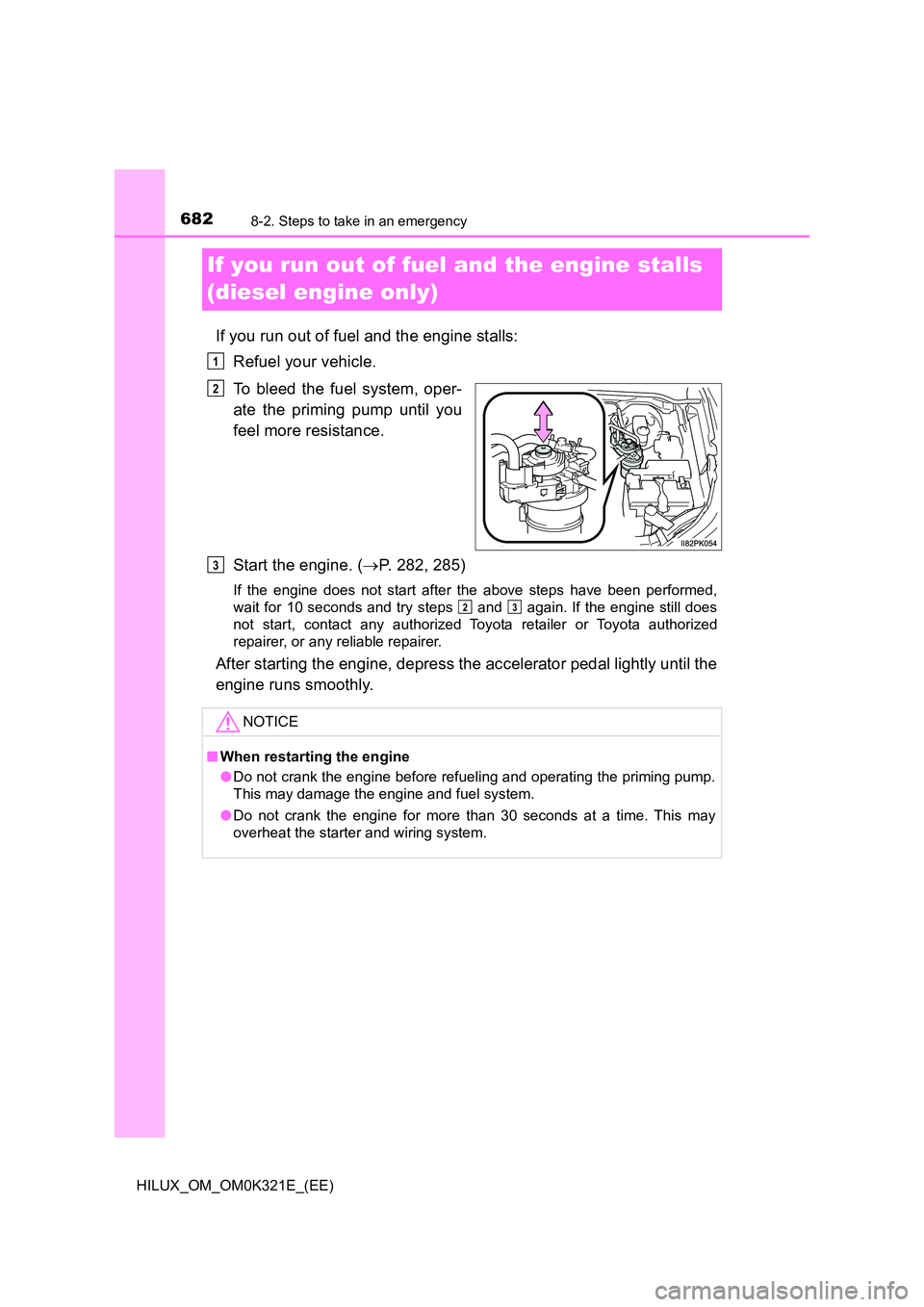
6828-2. Steps to take in an emergency
HILUX_OM_OM0K321E_(EE)
If you run out of fuel and the engine stalls
(diesel engine only)
If you run out of fuel and the engine stalls:
Refuel your vehicle.
To bleed the fuel system, oper-
ate the priming pump until you
feel more resistance.
Start the engine. ( P. 282, 285)
If the engine does not start after the above steps have been performed,
wait for 10 seconds and try steps and again. If the engine still does
not start, contact any authorized Toyo ta retailer or Toyota authorized
repairer, or any reliable repairer.
After starting the engine, depress the accelerator pedal lightly until the
engine runs smoothly.
1
2
NOTICE
■ When restarting the engine
● Do not crank the engine before refueling and operating the priming pump.
This may damage the engine and fuel system.
● Do not crank the engine for more than 30 seconds at a time. This may
overheat the starter and wiring system.
3
23
Page 707 of 744
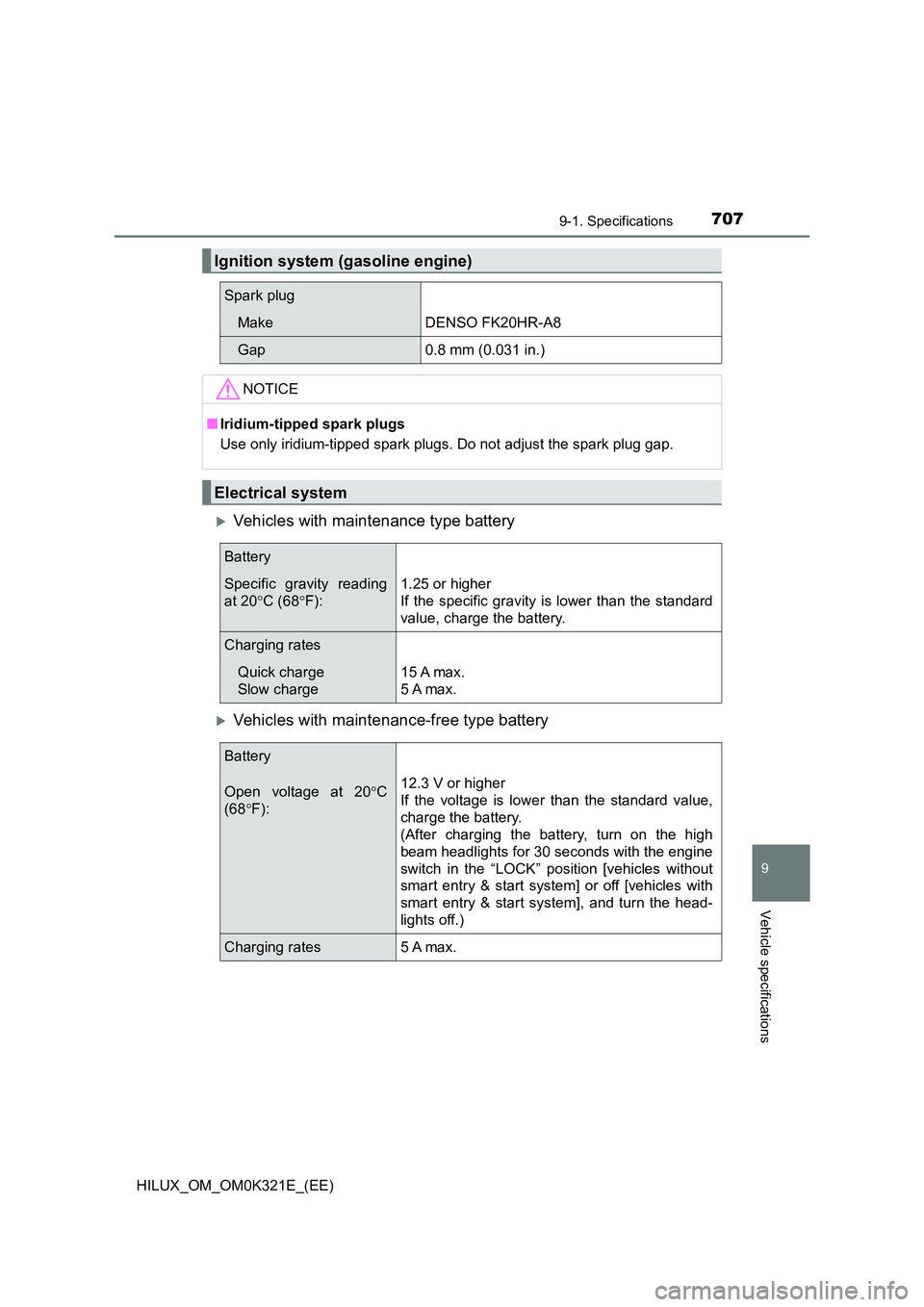
707
9
9-1. Specifications
Vehicle specifications
HILUX_OM_OM0K321E_(EE)
Vehicles with maintenance type battery
Vehicles with maintenance-free type battery
Ignition system (gasoline engine)
Spark plug
MakeDENSO FK20HR-A8
Gap0.8 mm (0.031 in.)
NOTICE
■Iridium-tipped spark plugs
Use only iridium-tipped spark plugs. Do not adjust the spark plug gap.
Electrical system
Battery
Specific gravity reading
at 20 C (68F):
1.25 or higher
If the specific gravity is lower than the standard
value, charge the battery.
Charging rates
Quick charge
Slow charge
15 A max.
5 A max.
Battery
Open voltage at 20 C
(68 F):
12.3 V or higher
If the voltage is lower than the standard value,
charge the battery.
(After charging the battery, turn on the high
beam headlights for 30 seconds with the engine
switch in the “LOCK” position [vehicles without
smart entry & start system] or off [vehicles with
smart entry & start system], and turn the head-
lights off.)
Charging rates 5 A max.
Page 714 of 744
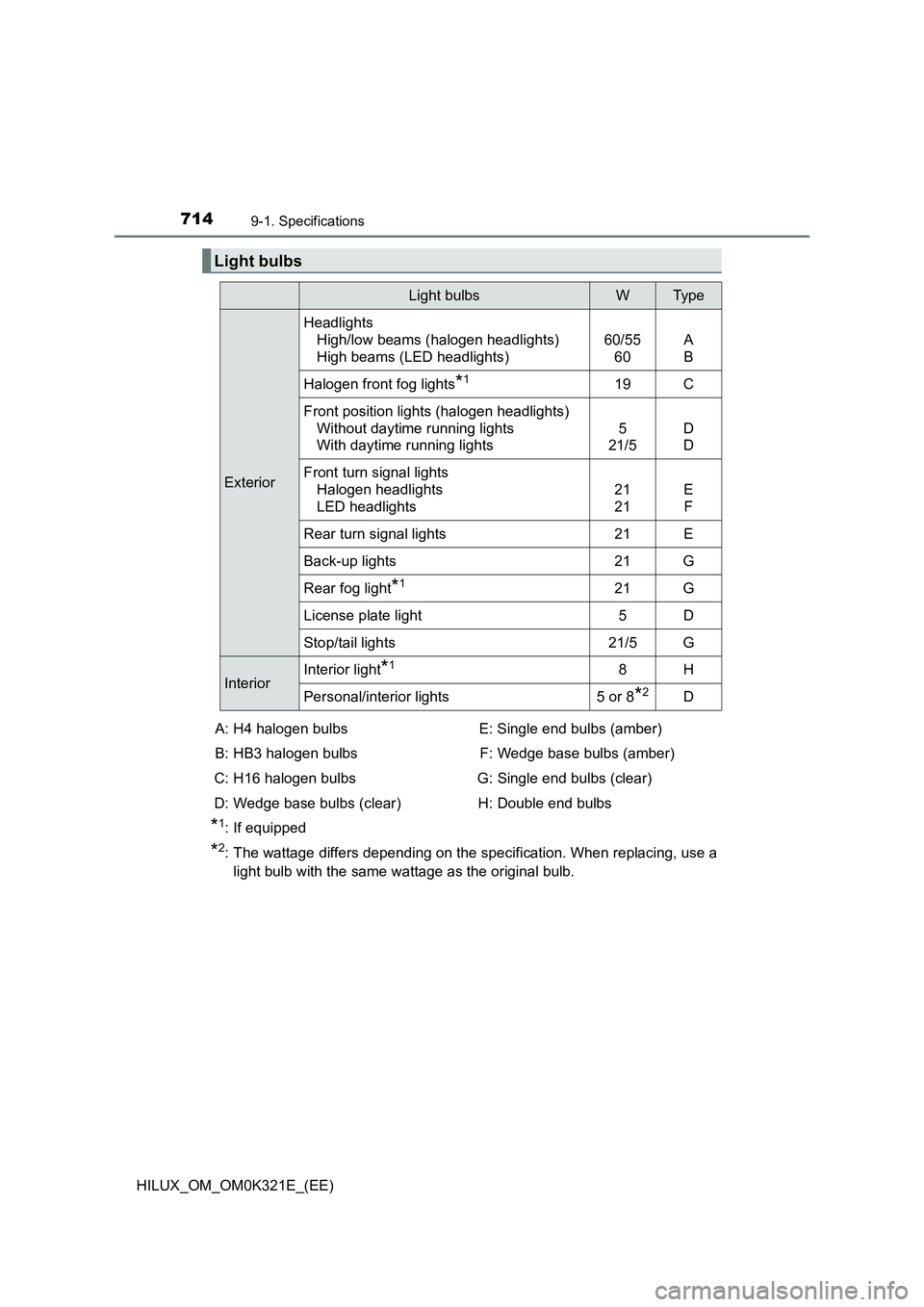
7149-1. Specifications
HILUX_OM_OM0K321E_(EE)
*1: If equipped
*2: The wattage differs depending on the specification. When replacing, use a
light bulb with the same wattage as the original bulb.
Light bulbs
Light bulbsWTyp e
Exterior
Headlights
High/low beams (halogen headlights)
High beams (LED headlights)
60/55
60
A
B
Halogen front fog lights*119 C
Front position lights (halogen headlights)
Without daytime running lights
With daytime running lights
5
21/5
D
D
Front turn signal lights
Halogen headlights
LED headlights
21
21
E
F
Rear turn signal lights 21 E
Back-up lights 21 G
Rear fog light*121 G
License plate light 5 D
Stop/tail lights 21/5 G
Interior Interior light*18H
Personal/interior lights 5 or 8*2D
A: H4 halogen bulbs
B: HB3 halogen bulbs
C: H16 halogen bulbs
D: Wedge base bulbs (clear)
E: Single end bulbs (amber)
F: Wedge base bulbs (amber)
G: Single end bulbs (clear)
H: Double end bulbs
Page 716 of 744
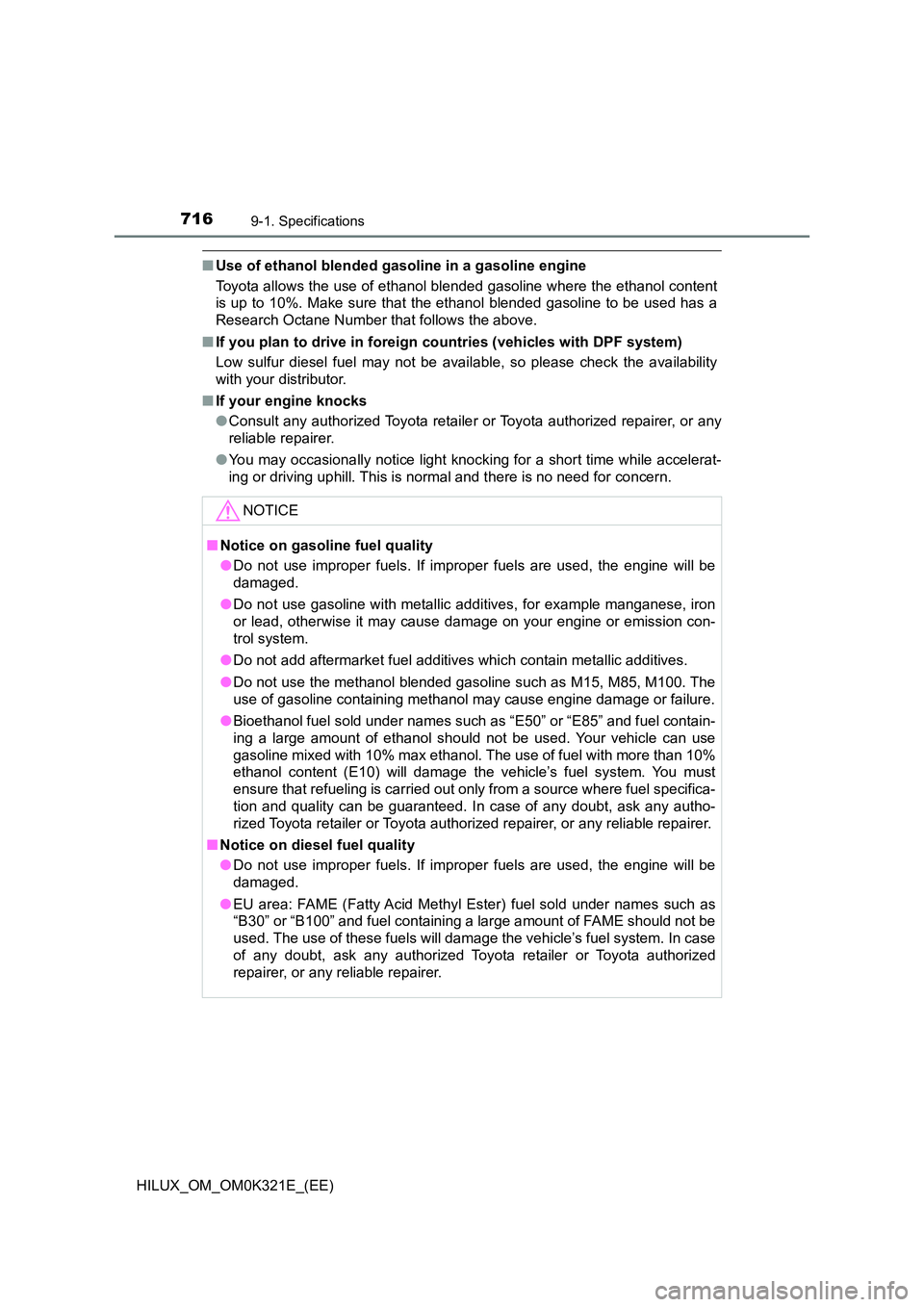
7169-1. Specifications
HILUX_OM_OM0K321E_(EE)
■Use of ethanol blended gasoline in a gasoline engine
Toyota allows the use of ethanol blended gasoline where the ethanol content
is up to 10%. Make sure that the ethanol blended gasoline to be used has a
Research Octane Number that follows the above.
■ If you plan to drive in foreign countries (vehicles with DPF system)
Low sulfur diesel fuel may not be avai lable, so please check the availability
with your distributor.
■ If your engine knocks
● Consult any authorized Toyota retailer or Toyota authorized repairer, or any
reliable repairer.
● You may occasionally notice light knocking for a short time while accelerat-
ing or driving uphill. This is normal and there is no need for concern.
NOTICE
■ Notice on gasoline fuel quality
● Do not use improper fuels. If improper fuels are used, the engine will be
damaged.
● Do not use gasoline with metallic additives, for example manganese, iron
or lead, otherwise it may cause damage on your engine or emission con-
trol system.
● Do not add aftermarket fuel additives which contain metallic additives.
● Do not use the methanol blended gasoline such as M15, M85, M100. The
use of gasoline containing methanol may cause engine damage or failure.
● Bioethanol fuel sold under names such as “E50” or “E85” and fuel contain-
ing a large amount of ethanol should not be used. Your vehicle can use
gasoline mixed with 10% max ethanol. The use of fuel with more than 10%
ethanol content (E10) will damage the vehicle’s fuel system. You must
ensure that refueling is carried out only from a source where fuel specifica-
tion and quality can be guaranteed. In case of any doubt, ask any autho-
rized Toyota retailer or Toyota authorized repairer, or any reliable repairer.
■ Notice on diesel fuel quality
● Do not use improper fuels. If improper fuels are used, the engine will be
damaged.
● EU area: FAME (Fatty Acid Methyl Ester) fuel sold under names such as
“B30” or “B100” and fuel containing a large amount of FAME should not be
used. The use of these fuels will damage the vehicle’s fuel system. In case
of any doubt, ask any authorized Toyota retailer or Toyota authorized
repairer, or any reliable repairer.
Page 719 of 744

7199-2. Customization
HILUX_OM_OM0K321E_(EE)
9
Vehicle specifications
Settings that can be changed using the multi-information display
Settings that can be changed by any authorized Toyota retailer or
Toyota authorized repairer, or any reliable repairer
Definition of symbols: O = Available, – = Not available
■Gauges, meters and multi-information display*1 ( P. 147, 151)
Vehicles with multi-information display type A
Customizable features
1
2
Function*2Default settingCustomized
setting
Language*3English
German
O–
French
Spanish
Italian
Russian
Turkish
Thai
Portuguese
Indonesian
Units*3km (L/100 km) km (km/L) O–miles (MPG)
Eco Driving Indicator Light On
(Self-lighting) Off O –
12